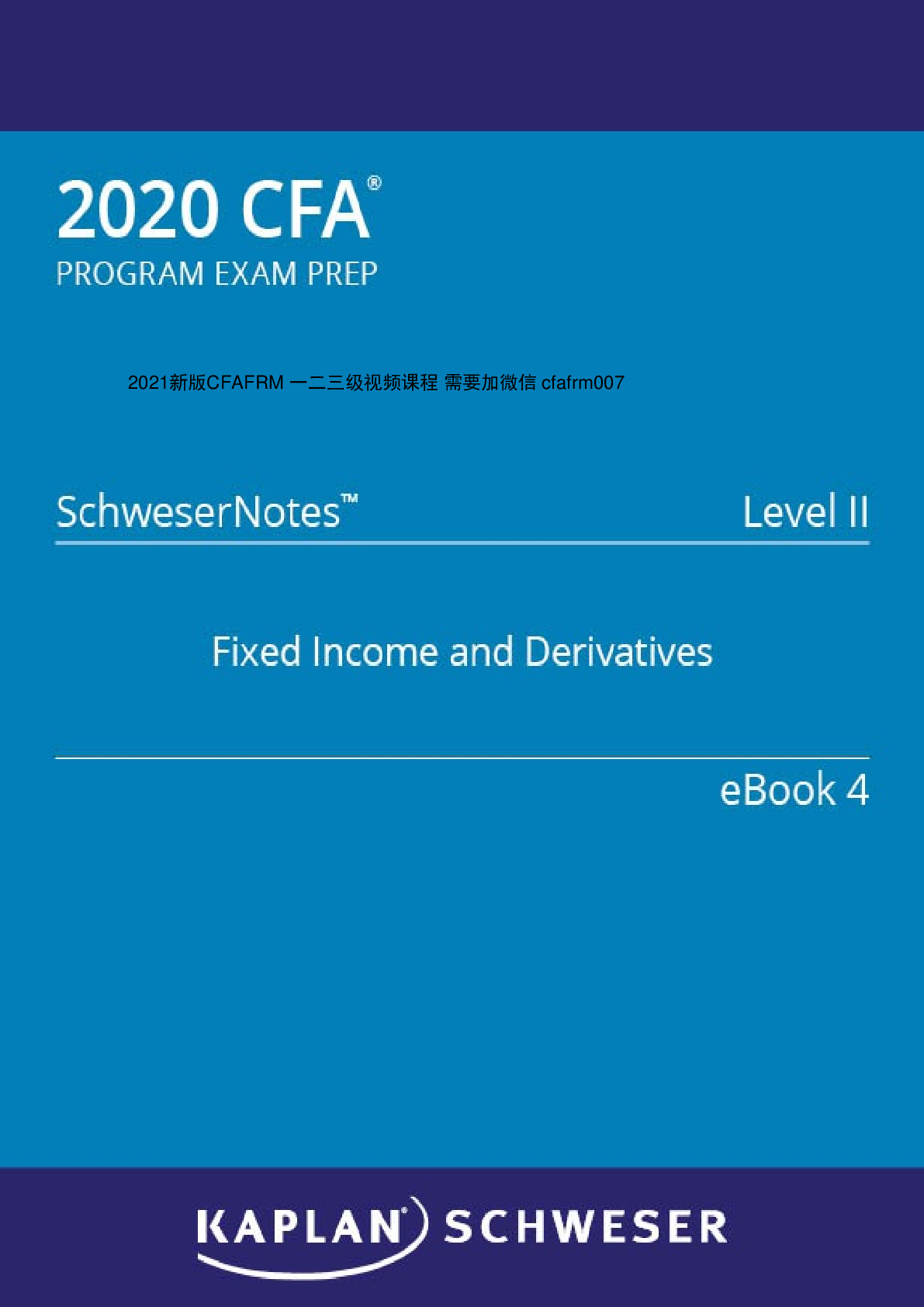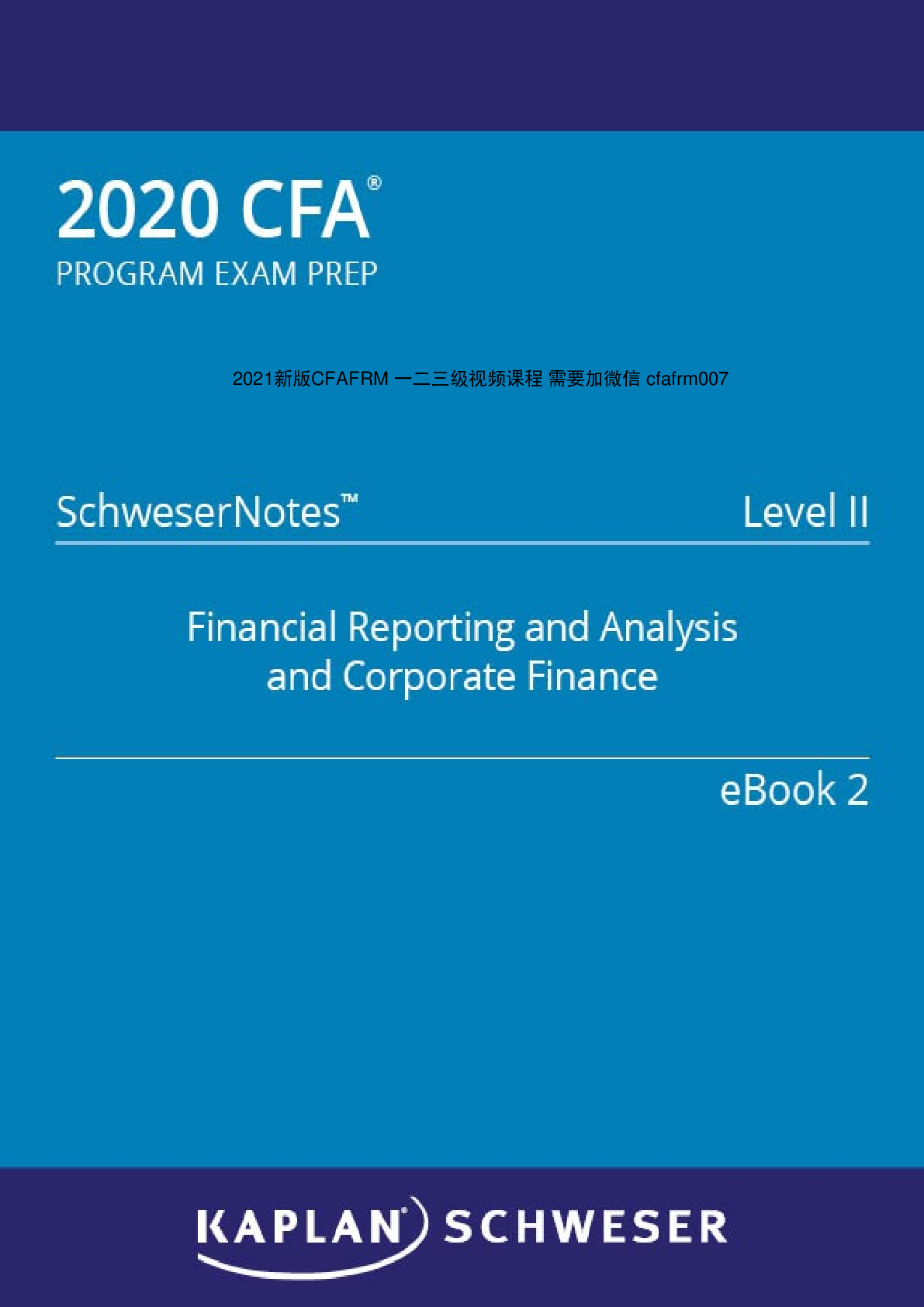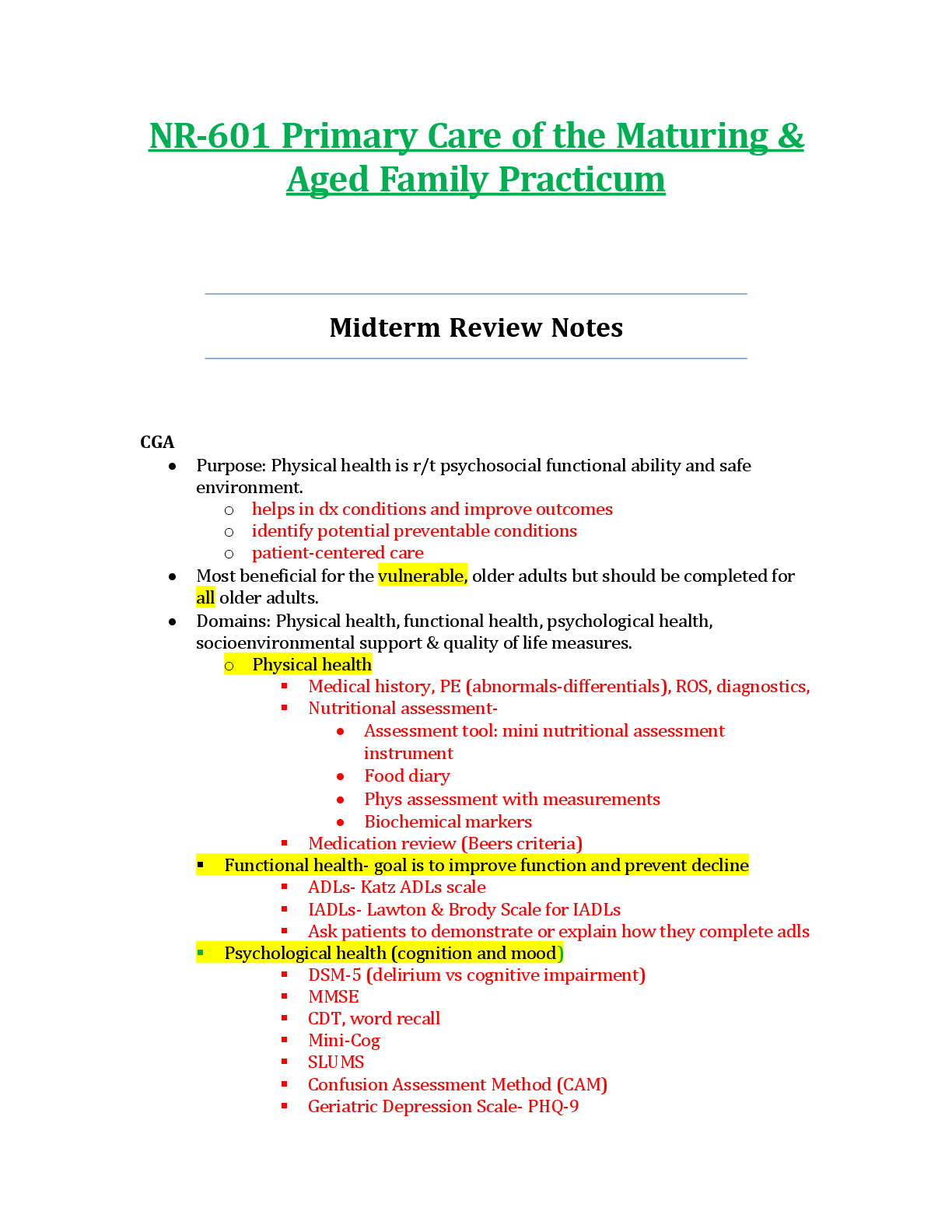Finance > Study Notes > Finance 11 _ SchweserNotes_Book_3_2_113_2020 CFA Program Exam Preparation | Equity (All)
Finance 11 _ SchweserNotes_Book_3_2_113_2020 CFA Program Exam Preparation | Equity
Document Content and Description Below
STUDY SESSION 9 The topical coverage corresponds with the following CFA Institute assigned reading: 24. Equity Valuation: Applications and Processes The candidate should be able to: a. define valu ... ation and intrinsic value and explain sources of perceived mispricing. (page 1) b. explain the going concern assumption and contrast a going concern value to a liquidation value. (page 2) c. describe definitions of value and justify which definition of value is most relevant to public company valuation. (page 2) d. describe applications of equity valuation. (page 2) e. describe questions that should be addressed in conducting an industry and competitive analysis. (page 4) f. contrast absolute and relative valuation models and describe examples of each type of model. (page 5) g. describe sum-of-the-parts valuation and conglomerate discounts. (page 6) h. explain broad criteria for choosing an appropriate approach for valuing a given company. (page 7) The topical coverage corresponds witfh the following CFA Institute assigned reading: 25. Return Concepts The candidate should be able to: a. distinguish among realized holding period return, expected holding period return, required return, return from convergence of price to intrinsic value, discount rate, and internal rate of return. (page 13) b. calculate and interpret an equity risk premium using historical and forward-looking estimation approaches. (page 15) c. estimate the required return on an equity investment using the capital asset pricing model, the Fama–French model, the Pastor–Stambaugh model, macroeconomic multifactor models, and the build-up method (e.g., bond yield plus risk premium). (page 19) d. explain beta estimation for public companies, thinly traded public companies, and nonpublic companies. (page 23) e. describe strengths and weaknesses of methods used to estimate the required return on an equity investment. (page 25) f. explain international considerations in required return estimation. (page 25) g. explain and calculate the weighted average cost of capital for a company. (page 26) h. evaluate the appropriateness of using a particular rate of return as a discount rate, given a description of the cash flow to be discounted and other relevant facts. (page 27) 2021新版CFAFRM 一二三级视频课程 需要加微信 cfafrm007STUDY SESSION 10 The topical coverage corresponds with the following CFA Institute assigned reading: 26. Industry and Company Analysis The candidate should be able to: a. compare top-down, bottom-up, and hybrid approaches for developing inputs to equity valuation models. (page 35) b. compare “growth relative to GDP growth” and “market growth and market share” approaches to forecasting revenue. (page 36) c. evaluate whether economies of scale are present in an industry by analyzing operating margins and sales levels. (page 36) d. forecast the following costs: cost of goods sold, selling general and administrative costs, financing costs, and income taxes. (page 37) e. describe approaches to balance sheet modeling. (page 39) f. describe the relationship between return on invested capital and competitive advantage. (page 40) g. explain how competitive factors affect prices and costs. (page 40) h. judge the competitive position of a company based on a Porter’s Five Forces analysis. (page 40) i. explain how to forecast industry and company sales and costs when they are subject to price inflation or deflation. (page 41) j. evaluate the effects of technological developments on demand, selling prices, costs, and margins. (page 44) k. explain considerations in the choice of an explicit forecast horizon. (page 45) l. explain an analyst’s choices in developing projections beyond the short-term forecast horizon. (page 46) m. demonstrate the development of a sales-based pro forma company model. (page 46) The topical coverage corresponds with the following CFA Institute assigned reading: 27. Discounted Dividend Valuation The candidate should be able to: a. compare dividends, free cash flow, and residual income as inputs to discounted cash flow models and identify investment situations for which each measure is suitable. (page 63) b. calculate and interpret the value of a common stock using the dividend discount model (DDM) for single and multiple holding periods. (page 66) c. calculate the value of a common stock using the Gordon growth model and explain the model’s underlying assumptions. (page 69) d. calculate and interpret the implied growth rate of dividends using the Gordon growth model and current stock price. (page 71) e. calculate and interpret the present value of growth opportunities (PVGO) and the component of the leading price-to-earnings ratio (P/E) related to PVGO. (page 71) f. calculate and interpret the justified leading and trailing P/Es using the Gordon growth model. (page 72) g. calculate the value of noncallable fixed-rate perpetual preferred stock. (page 74) h. describe strengths and limitations of the Gordon growth model and justify its selection to value a company’s common shares. (page 75) i. explain the assumptions and justify the selection of the two-stage DDM, the H-model, the three-stage DDM, or spreadsheet modeling to value a company’s common shares.(page 76) j. explain the growth phase, transition phase, and maturity phase of a business. (page 79) k. describe terminal value and explain alternative approaches to determining the terminal value in a DDM. (page 80) l. calculate and interpret the value of common shares using the two-stage DDM, the Hmodel, and the three-stage DDM. (page 81) m. estimate a required return based on any DDM, including the Gordon growth model and the H-model. (page 86) n. explain the use of spreadsheet modeling to forecast dividends and to value common shares. (page 89) o. calculate and interpret the sustainable growth rate of a company and demonstrate the use of DuPont analysis to estimate a company’s sustainable growth rate. (page 90) p. evaluate whether a stock is overvalued, fairly valued, or undervalued by the market based on a DDM estimate of value. (page 92)STUDY SESSION 11 The topical coverage corresponds with the following CFA Institute assigned reading: 28. Free Cash Flow Valuation The candidate should be able to: a. compare the free cash flow to the firm (FCFF) and free cash flow to equity (FCFE) approaches to valuation. (page 109) b. explain the ownership perspective implicit in the FCFE approach. (page 111) c. explain the appropriate adjustments to net income, earnings before interest and taxes (EBIT), earnings before interest, taxes, depreciation, and amortization (EBITDA), and cash flow from operations (CFO) to calculate FCFF and FCFE. (page 112) d. calculate FCFF and FCFE. (page 120) e. describe approaches for forecasting FCFF and FCFE. (page 124) f. compare the FCFE model and dividend discount models. (page 124) g. explain how dividends, share repurchases, share issues, and changes in leverage may affect future FCFF and FCFE. (page 125) h. evaluate the use of net income and EBITDA as proxies for cash flow in valuation. (page 125) i. explain the single-stage (stable-growth), two-stage, and three-stage FCFF and FCFE models and select and justify the appropriate model given a company’s characteristics. (page 126) j. estimate a company’s value using the appropriate free cash flow model(s). (page 129) k. explain the use of sensitivity analysis in FCFF and FCFE valuations. (page 136) l. describe approaches for calculating the terminal value in a multistage valuation model. (page 136) m. evaluate whether a stock is overvalued, fairly valued, or undervalued based on a free cash flow valuation model. (page 137) The topical coverage corresponds with the following CFA Institute assigned reading: 29. Market-Based Valuation: Price and Enterprise Value Multiples The candidate should be able to: a. distinguish between the method of comparables and the method based on forecasted fundamentals as approaches to using price multiples in valuation, and explain economic rationales for each approach. (page 152) b. calculate and interpret a justified price multiple. (page 153) c. describe rationales for and possible drawbacks to using alternative price multiples and dividend yield in valuation. (page 153) d. calculate and interpret alternative price multiples and dividend yield. (page 153) e. calculate and interpret underlying earnings, explain methods of normalizing earnings per share (EPS), and calculate normalized EPS. (page 160) f. explain and justify the use of earnings yield (E/P). (page 162) g. describe fundamental factors that influence alternative price multiples and dividend yield. (page 162) h. calculate and interpret the justified price-to-earnings ratio (P/E), price-to-book ratio (P/B), and price-to-sales ratio (P/S) for a stock, based on forecasted fundamentals. (page 162) i. calculate and interpret a predicted P/E, given a cross-sectional regression on fundamentals, and explain limitations to the cross-sectional regression methodology. (page 166)j. evaluate a stock by the method of comparables and explain the importance of fundamentals in using the method of comparables. (page 168) k. calculate and interpret the P/E-to-growth ratio (PEG) and explain its use in relative valuation. (page 171) l. calculate and explain the use of price multiples in determining terminal value in a multistage discounted cash flow (DCF) model. (page 172) m. explain alternative definitions of cash flow used in price and enterprise value (EV) multiples and describe limitations of each definition. (page 173) n. calculate and interpret EV multiples and evaluate the use of EV/EBITDA. (page 174) o. explain sources of differences in cross-border valuation comparisons. (page 176) p. describe momentum indicators and their use in valuation. (page 176) q. explain the use of the arithmetic mean, the harmonic mean, the weighted harmonic mean, and the median to describe the central tendency of a group of multiples. (page 177) r. evaluate whether a stock is overvalued, fairly valued, or undervalued based on comparisons of multiples. (page 168) The topical coverage corresponds with the following CFA Institute assigned reading: 30. Residual Income Valuation a. calculate and interpret residual income, economic value added, and market value added. (page 197) b. describe the uses of residual income models. (page 200) c. calculate the intrinsic value of a common stock using the residual income model and compare value recognition in residual income and other present value models. (page 200) d. explain fundamental determinants of residual income. (page 203) e. explain the relation between residual income valuation and the justified price-to-book ratio based on forecasted fundamentals. (page 204) f. calculate and interpret the intrinsic value of a common stock using single-stage (constant-growth) and multistage residual income models. (page 204) g. calculate the implied growth rate in residual income, given the market price-to-book ratio and an estimate of the required rate of return on equity. (page 205) h. explain continuing residual income and justify an estimate of continuing residual income at the forecast horizon, given company and industry prospects. (page 207) i. compare residual income models to dividend discount and free cash flow models. (page 214) j. explain strengths and weaknesses of residual income models and justify the selection of a residual income model to value a company’s common stock. (page 214) k. describe accounting issues in applying residual income models. (page 215) l. evaluate whether a stock is overvalued, fairly valued, or undervalued based on a residual income model. (page 217) The topical coverage corresponds with the following cFa Institute assigned reading: 31. Private Company Valuation The candidate should be able to: a. compare public and private company valuation. (page 229) b. describe uses of private business valuation and explain applications of greatest concern to financial analysts. (page 231) c. explain various definitions of value and demonstrate how different definitions can lead to different estimates of value. (page 232)d. explain the income, market, and asset-based approaches to private company valuation and factors relevant to the selection of each approach. (page 234) e. explain cash flow estimation issues related to private companies and adjustments required to estimate normalized earnings. (page 235) f. calculate the value of a private company using free cash flow, capitalized cash flow, and/or excess earnings methods. (page 240) g. explain factors that require adjustment when estimating the discount rate for private companies. (page 243) h. compare models used to estimate the required rate of return to private company equity (for example, the CAPM, the expanded CAPM, and the build-up approach). (page 244) i. calculate the value of a private company based on market approach methods and describe advantages and disadvantages of each method. (page 249) j. describe the asset-based approach to private company valuation. (page 253) k. explain and evaluate the effects on private company valuations of discounts and premiums based on control and marketability. (page 254) l. describe the role of valuation standards in valuing private companies. (page 258)Video covering this content is available online. The following is a review of the Equity Valuation (1) principles designed to address the learning outcome statements set forth by CFA Institute. Cross-Reference to CFA Institute Assigned Reading #24. READING 24: EQUITY VALUATION: APPLICATIONS AND PROCESSES Study Session 9 EXAM FOCUS This review is simply an introduction to the process of equity valuation and its application. Many of the concepts and techniques introduced are developed more fully in subsequent topic reviews. Candidates should be familiar with the concepts introduced here, including intrinsic value, analyst perception of mispricing, going concern versus liquidation value, and the difference between absolute and relative valuation techniques. MODULE 24.1: EQUITY VALUATION: APPLICATIONS AND PROCESSES LOS 24.a: Define valuation and intrinsic value and explain sources of perceived mispricing. CFA® Program Curriculum: Volume 4, page 6 Valuation is the process of determining the value of an asset. There are many approaches and estimating the inputs for a valuation model can be quite challenging. Investment success, however, can depend crucially on the analyst’s ability to determine the values of securities. When we use the term intrinsic value (IV), we are referring to the valuation of an asset or security by someone who has complete understanding of the characteristics of the asset or issuing firm. To the extent that stock prices are not perfectly (informationally) efficient, they may diverge from the intrinsic values. Analysts seeking to produce positive risk-adjusted returns do so by trying to identify securities for which their estimate of intrinsic value differs from current market price. One framework divides mispricing perceived by the analyst into two sources: the difference between market price and the intrinsic value (actual mispricing) and the difference between the analyst’s estimate of intrinsic value and actual intrinsic value (valuation error). We can represent this relation as follows: IV analyst − price = (IVactual − price) + (IVanalyst − IVactual) LOS 24.b: Explain the going concern assumption and contrast a going concern value to a liquidation value. CFA® Program Curriculum: Volume 4, page 8 The going concern assumption is simply the assumption that a company will continue to operate as a business, as opposed to going out of business. The valuation models we willcover are all based on the going concern assumption. An alternative, when it cannot be assumed that the company will continue to operate (survive) as a business, is a firm’s liquidation value. The liquidation value is the estimate of what the assets of the firm would bring if sold separately, net of the company’s liabilities. LOS 24.c: Describe definitions of value and justify which definition of value is most relevant to public company valuation. CFA® Program Curriculum: Volume 4, page 8 As stated earlier, intrinsic value is the most relevant metric for an analyst valuing public equities. However, other definitions of value may be relevant in other contexts. Fair market value is the price at which a hypothetical willing, informed, and able seller would trade an asset to a willing, informed, and able buyer. This definition is similar to the concept of fair value used for financial reporting purposes. A company’s market price should reflect its fair market value over time if the market has confidence that the company’s management is acting in the interest of equity investors. Investment value is the value of a stock to a particular buyer. Investment value may depend on the buyer’s specific needs and expectations, as well as perceived synergies with existing buyer assets. When valuing a company, an analyst should be aware of the purpose of valuation. For most investment decisions, intrinsic value is the relevant concept of value. For acquisitions, investment value may be more appropriate. LOS 24.d: Describe applications of equity valuation. CFA® Program Curriculum: Volume 4, page 9 PROFESSOR’S NOTE This is simply a list of the possible scenarios that may form the basis of an equity valuation question. No matter what the scenario is, the tools you will use are the same. Valuation is the process of estimating the value of an asset by (1) using a model based on the variables the analyst believes influence the fundamental value of the asset or (2) comparing it to the observable market value of “similar” assets. Equity valuation models are used by analysts in a number of ways. Rather than an end unto itself, valuation is a tool that is used in the pursuit of other objectives like those listed in the following paragraphs. The general steps in the equity valuation process are: 1. Understand the business. 2. Forecast company performance. 3. Select the appropriate valuation model. 4. Convert the forecasts into a valuation. 5. Apply the valuation conclusions. Stock selection. The most direct use of equity valuation is to guide the purchase, holding, or sale of stocks. Valuation is based on both a comparison of the intrinsic value of the stock with its market price and a comparison of its price with that of comparable stocks.Reading the market. Current market prices implicitly contain investors’ expectations about the future value of the variables that influence the stock’s price (e.g., earnings growth and expected return). Analysts can estimate these expectations by comparing market prices with a stock’s intrinsic value. Projecting the value of corporate actions. Many market professionals use valuation techniques to determine the value of proposed corporate mergers, acquisitions, divestitures, management buyouts (MBOs), and recapitalization efforts. Fairness opinions. Analysts use equity valuation to support professional opinions about the fairness of a price to be received by minority shareholders in a merger or acquisition. Planning and consulting. Many firms engage analysts to evaluate the effects of proposed corporate strategies on the firm’s stock price, pursuing only those that have the greatest value to shareholders. Communication with analysts and investors. The valuation approach provides management, investors, and analysts with a common basis upon which to discuss and evaluate the company’s performance, current state, and future plans. Valuation of private business. Analysts use valuation techniques to determine the value of firms or holdings in firms that are not publicly traded. Investors in nonpublic firms rely on these valuations to determine the value of their positions or proposed positions. Portfolio management. While equity valuation can be considered a stand-alone function in which the value of a single equity position is estimated, it can be more valuable when used in a portfolio management context to determine the value and risk of a portfolio of investments. The investment process is usually considered to have three parts: planning, execution, and evaluation of results. Equity valuation is a primary concern in the first two of these steps. Planning. The first step of the investment process includes defining investment objectives and constraints and articulating an investment strategy for selecting securities based on valuation parameters or techniques. Sometimes investors may not select individual equity positions, but the valuation techniques are implied in the selection of an index or other preset basket of securities. Active investment managers may use benchmarks as indicators of market expectations and then purposely deviate in composition or weighting to take advantage of their differing expectations. Executing the investment plan. The valuation of potential investments guides the implementation of an investment plan. The results of the specified valuation methods determine which investments will be made and which will be avoided. LOS 24.e: Describe questions that should be addressed in conducting an industry and competitive analysis. CFA® Program Curriculum: Volume 4, page 12 The five elements of industry structure as developed by Professor Michael Porter are: 1. Threat of new entrants in the industry. 2. Threat of substitutes. 3. Bargaining power of buyers. 4. Bargaining power of suppliers.5. Rivalry among existing competitors. The attractiveness (long-term profitability) of any industry is determined by the interaction of these five competitive forces (Porter’s five forces). There are three generic strategies a company may employ in order to compete and generate profits: 1. Cost leadership: Being the lowest-cost producer of the good. 2. Product differentiation: Addition of product features or services that increase the attractiveness of the firm’s product so that it will command a premium price in the market. 3. Focus: Employing one of the previous strategies within a particular segment of the industry in order to gain a competitive advantage. Once the analyst has identified a company’s strategy, she can evaluate the performance of the business over time in terms of how well it executes its strategy and how successful it is. The basic building blocks of equity valuation come from accounting information contained in the firm’s reports and releases. In order for the analyst to successfully estimate the value of the firm, the financial factors must be disclosed in sufficient detail and accuracy. Investigating the issues associated with the accuracy and detail of a firm’s disclosures is often referred to as a quality of financial statement information. This analysis requires examination of the firm’s income statement, balance sheet, and the notes to the financial statements. Studies have shown that the quality of earnings issue is reflected in a firm’s stock price, with firms with more transparent earnings having higher market values. An analyst can often only discern important results of management discretion through a detailed examination of the footnotes accompanying the financial reports. Quality of earnings issues can be broken down into several categories and may be addressed only in the footnotes and disclosures to the financial statements. Accelerating or premature recognition of income. Firms have used a variety of techniques to justify the recognition of income before it traditionally would have been recognized. These include recording sales and billing customers before products are shipped or accepted and bill and hold schemes in which items are billed in advance and held for future delivery. These schemes have been used to obscure declines in operating performance and boost reported revenue and income. Reclassifying gains and nonoperating income. Firms occasionally have gains or income from sources that are peripheral to their operations. The reclassification of these items as operating income will distort the results of the firm’s continuing operations, often hiding underperformance or a decline in sales. Expense recognition and losses. Delaying the recognition of expenses, capitalizing expenses, and classifying operating expenses as nonoperating expenses is an opposite approach that has the same effect as reclassifying gains from peripheral sources, increasing operating income. Management also has discretion in creating and estimating reserves that reflect expected future liabilities, such as a bad debt reserve or a provision for expected litigation losses. Amortization, depreciation, and discount rates. Management has a great deal of discretion in the selection of amortization and depreciation methods, as well as the choice of discount ratesin determination of pension plan obligations. These decisions can reduce the current recognition of expenses, in effect deferring recognition to later periods. Off-balance-sheet issues. The firm’s balance sheet may not fully reflect the assets and liabilities of the firm. Special purpose entities (SPEs) can be used by the firm to increase sales (by recording sales to the SPE) or to obscure the nature and value of assets or liabilities. Leases can be structured as operating, rather than finance, leases in order to reduce the total liabilities reported on the balance sheet. LOS 24.f: Contrast absolute and relative valuation models and describe examples of each type of model. CFA® Program Curriculum: Volume 4, page 23 Absolute valuation models. An absolute valuation model is one that estimates an asset’s intrinsic value, which is its value arising from its investment characteristics without regard to the value of other firms. One absolute valuation approach is to determine the value of a firm today as the discounted or present value of all the cash flows expected in the future. Dividend discount models estimate the value of a share based on the present value of all expected dividends discounted at the opportunity cost of capital. Many analysts realize that equity holders are entitled to more than just the dividends and so expand the measure of cash flow to include all expected cash flow to the firm that is not payable to senior claims (bondholders, taxing authorities, and senior stockholders). These models include the free cash flow approach and the residual income approach. Another absolute approach to valuation is represented by asset-based models. This approach estimates a firm’s value as the sum of the market value of the assets it owns or controls. This approach is commonly used to value firms that own or control natural resources, such as oil fields, coal deposits, and other mineral claims. Relative valuation models. Another very common approach to valuation is to determine the value of an asset in relation to the values of other assets. This is the approach underlying relative valuation models. The most common models use market price as a multiple of an individual financial factor of the firm, such as earnings per share. The resulting ratio, priceto-earnings (P/E), is easily compared to that of other firms. If the P/E is higher than that of comparable firms, it is said to be relatively overvalued, that is, overvalued relative to the other firms (not necessarily overvalued on an intrinsic value basis). The converse is also true: if the P/E is lower than that of comparable firms, the firm is said to be relatively undervalued. LOS 24.g: Describe sum-of-the-parts valuation and conglomerate discounts. CFA® Program Curriculum: Volume 4, page 26 Rather than valuing a company as a single entity, an analyst can value individual parts of the firm and add them up to determine the value for the company as a whole. The value obtained is called the sum-of-the-parts value, or sometimes breakup value or private market value. This process is especially useful when the company operates multiple divisions (or product lines) with different business models and risk characteristics (i.e., a conglomerate). Conglomerate discount is based on the idea that investors apply a markdown to the value of a company that operates in multiple unrelated industries, compared to the value a company thathas a single industry focus. Conglomerate discount is thus the amount by which market value under-represents sum-of-the-parts value. Three explanations for conglomerate discounts are: 1. Internal capital inefficiency: The company’s allocation of capital to different divisions may not have been based on sound decisions. 2. Endogenous (internal) factors: For example, the company may have pursued unrelated business acquisitions to hide poor operating performance. 3. Research measurement errors: Some hypothesize that conglomerate discounts do not exist, but rather are a result of incorrect measurement. LOS 24.h: Explain broad criteria for choosing an appropriate approach for valuing a given company. CFA® Program Curriculum: Volume 4, page 29 When selecting an approach for valuing a given company, an analyst should consider whether the model: Fits the characteristics of the company (e.g., Does it pay dividends? Is earnings growth estimable? Does it have significant intangible assets?). Is appropriate based on the quality and availability of input data. Is suitable given the purpose of the analysis. The purpose of the analysis may be, for example, valuation for making a purchase offer for a controlling interest in the company. In this case, a model based on cash flow may be more appropriate than one based on dividends because a controlling interest would allow the purchaser to set dividend policy. One thing to remember with respect to choice of a valuation model is that the analyst does not have to consider only one. Using multiple models and examining differences in estimated values can reveal how a model’s assumptions and the perspective of the analysis are affecting the estimated values. MODULE QUIZ 24.1 To best evaluate your performance, enter your quiz answers online. 1. Susan Weiber, CFA, has noted that even her best estimates of a stock’s intrinsic value can differ significantly from the current market price. The least likely explanation is: A. differences between her estimate and the actual intrinsic value. B. differences between the actual intrinsic value and the market price. C. differences between the intrinsic value and the going concern value. 2. An appropriate valuation approach for a company that is going out of business would be to calculate its: A. residual income value. B. dividend discount model value. C. liquidation value. 3. Davy Jarvis, CFA, is performing an equity valuation as part of the planning and execution phase of the portfolio management process. His results will also be useful for: A. communication with analysts and investors. B. technical analysis. C. benchmarking.4. The five elements of industry structure, as outlined by Michael Porter, include: A. the threat of substitutes. B. product differentiation. C. cost leadership. 5. Tom Walder has been instructed to use absolute valuation models, and not relative valuation models, in his analysis. Which of the following is least likely to be an example of an absolute valuation model? A. The dividend discount model. B. The price-to-earnings market multiple model. C. The residual income model. 6. Davy Jarvis, CFA, is performing an equity valuation and reviews his notes for key points he wanted to cover when planning the valuation. He finds the following questions: [Show More]
Last updated: 3 years ago
Preview 1 out of 246 pages
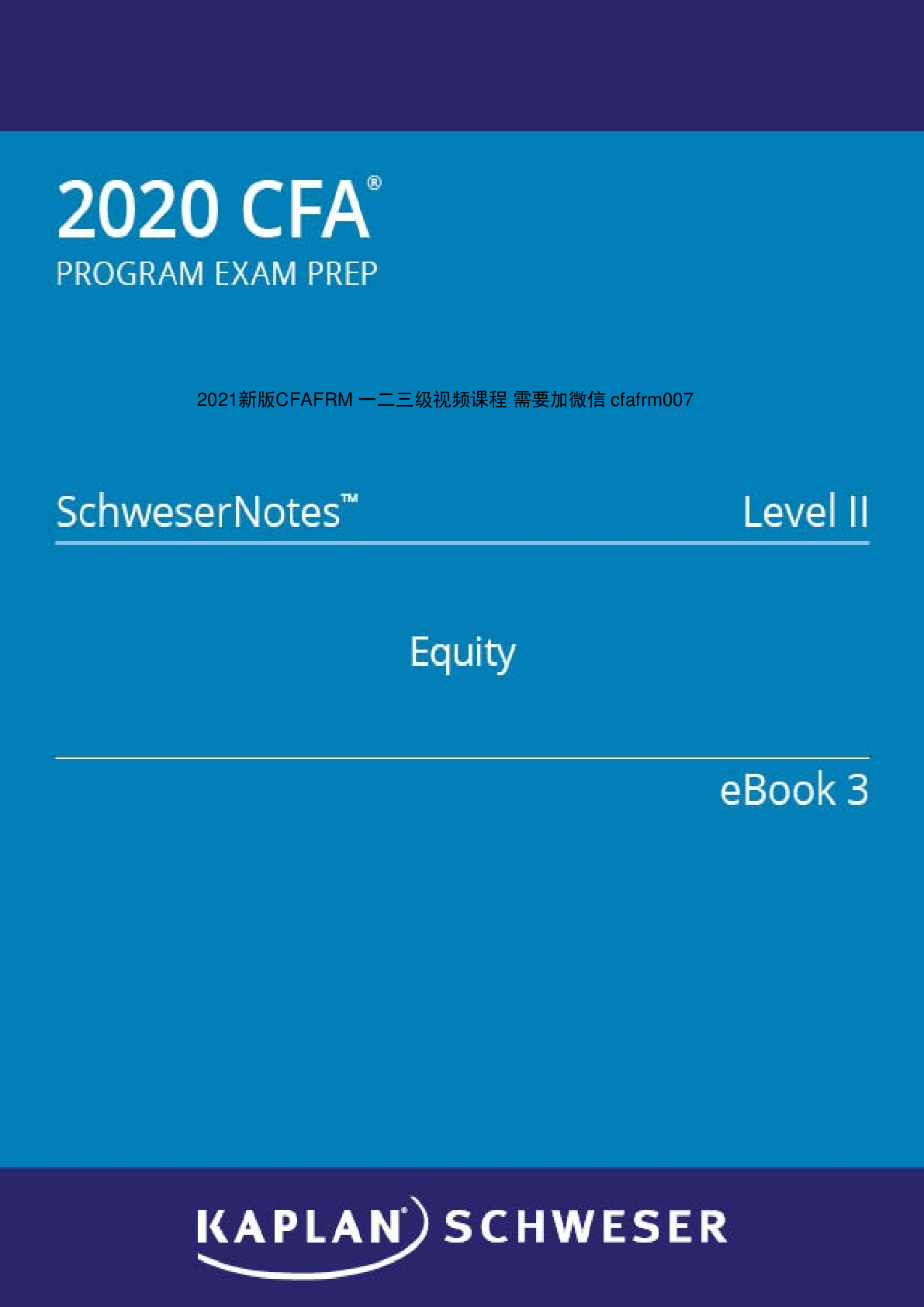
Buy this document to get the full access instantly
Instant Download Access after purchase
Buy NowInstant download
We Accept:

Also available in bundle (1)
Click Below to Access Bundle(s)
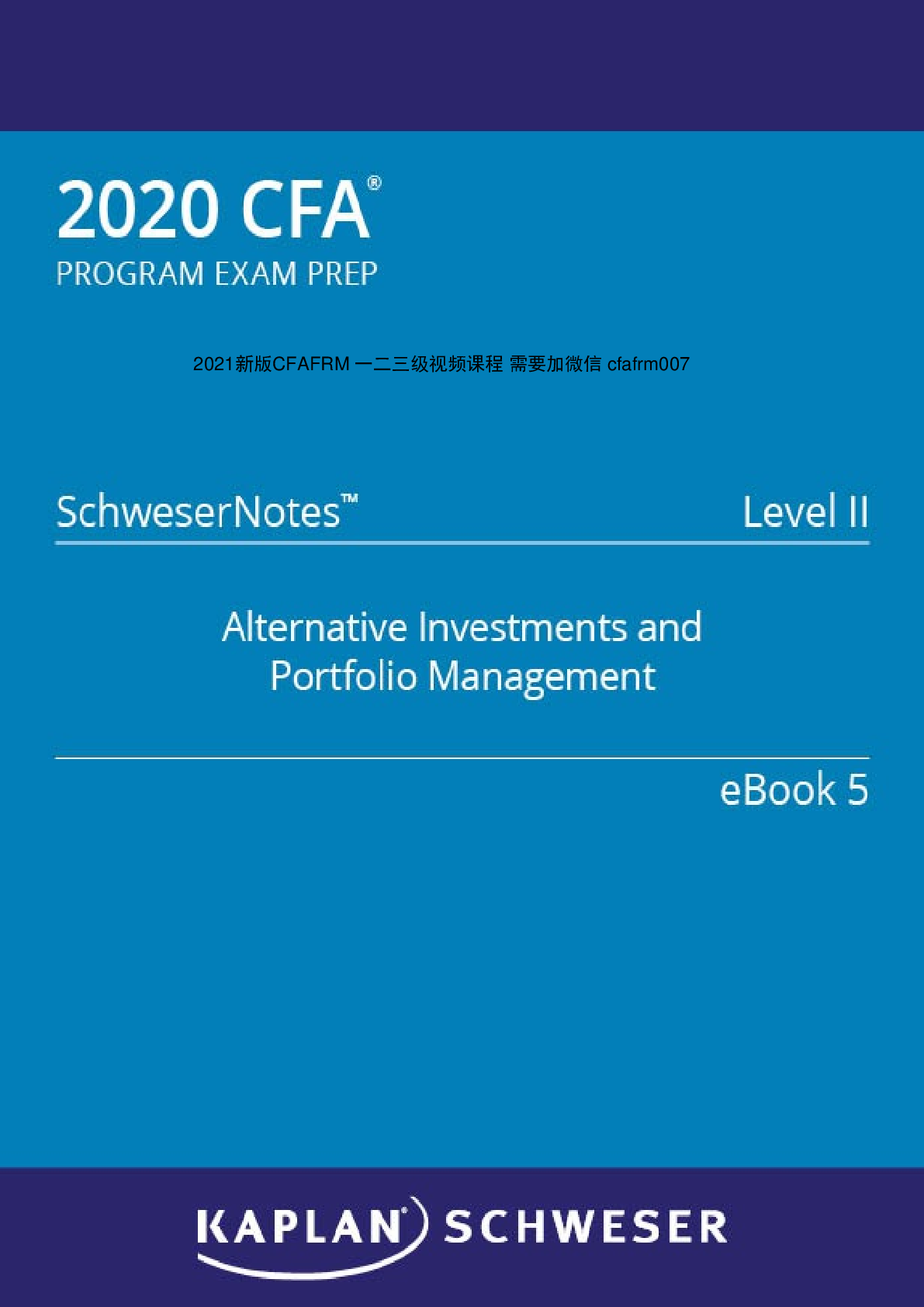
Finance 11 _ Schweser Notes_Book_BUNDLE
Ethical and Professional Standards, Quantitate Methods and Economics Financial Reporting and Analysis and Corporate Finance Equity Fixed income Derivatives Alternative Investments and Portfolio Ma...
By Elli 4 years ago
$71
5
Reviews( 0 )
$18.50
Can't find what you want? Try our AI powered Search
Document information
Connected school, study & course
About the document
Uploaded On
Apr 21, 2021
Number of pages
246
Written in
All
Additional information
This document has been written for:
Uploaded
Apr 21, 2021
Downloads
0
Views
132


